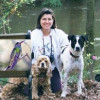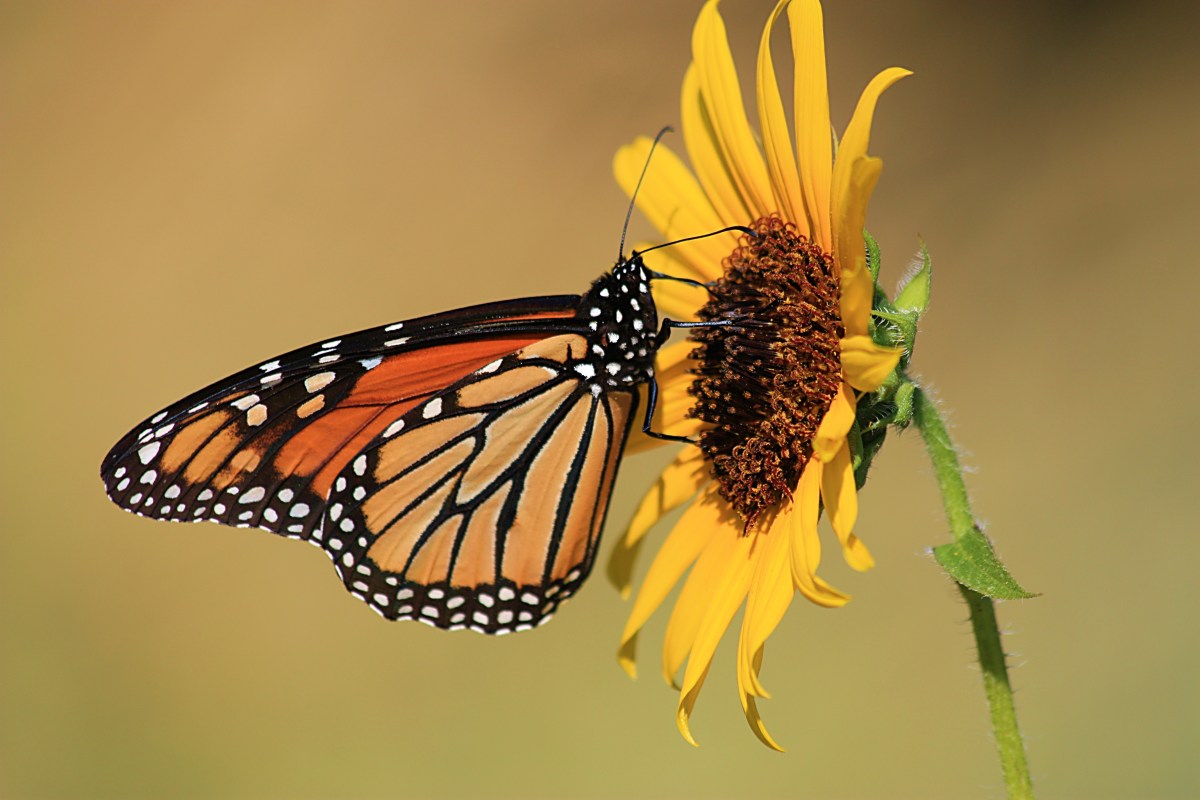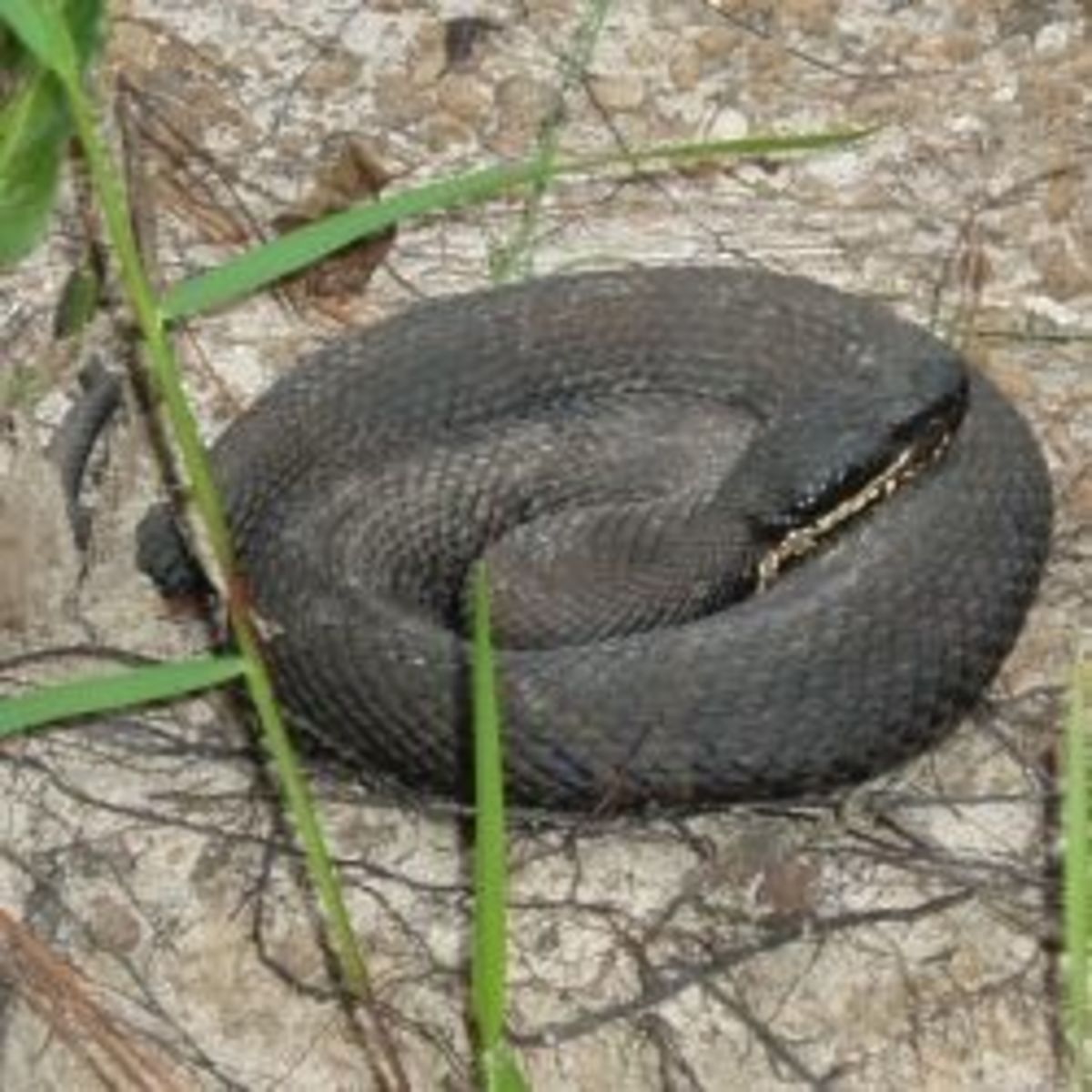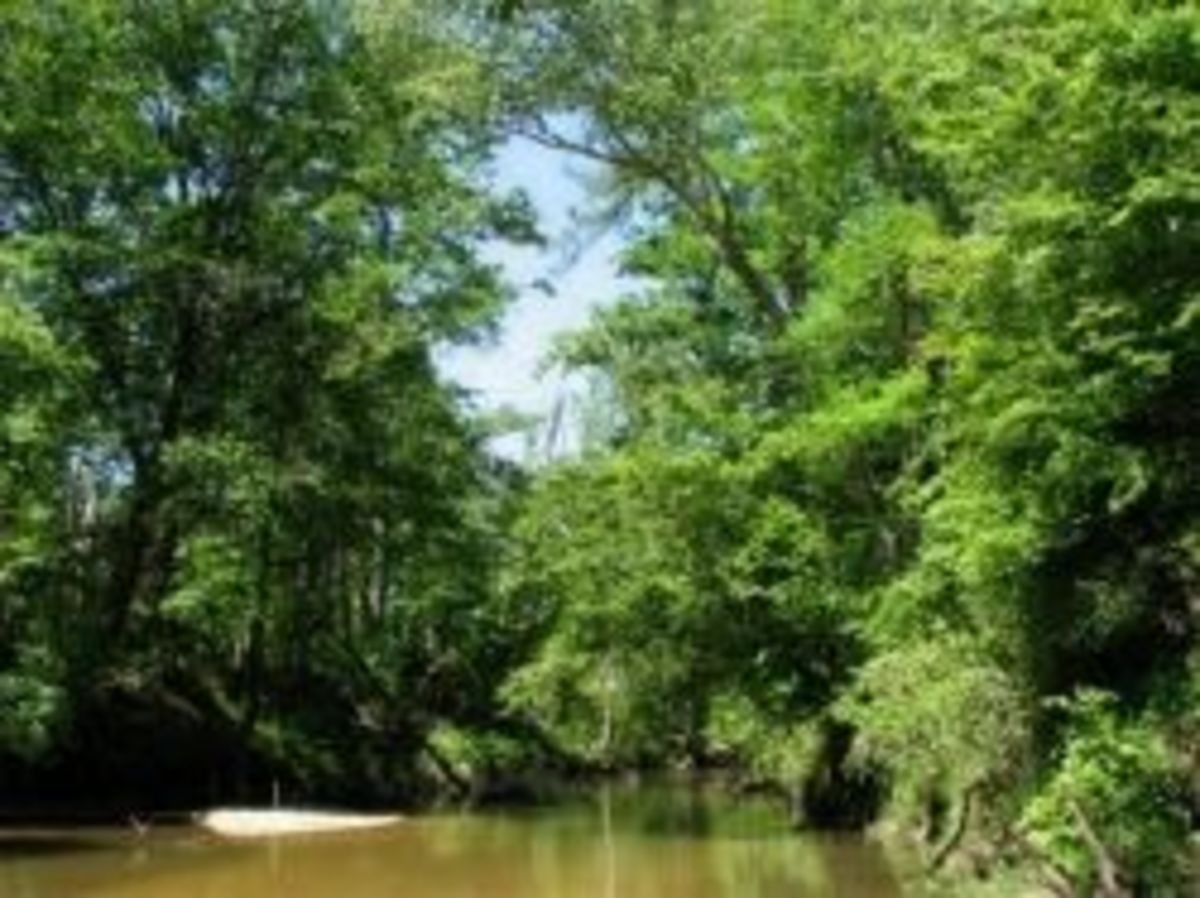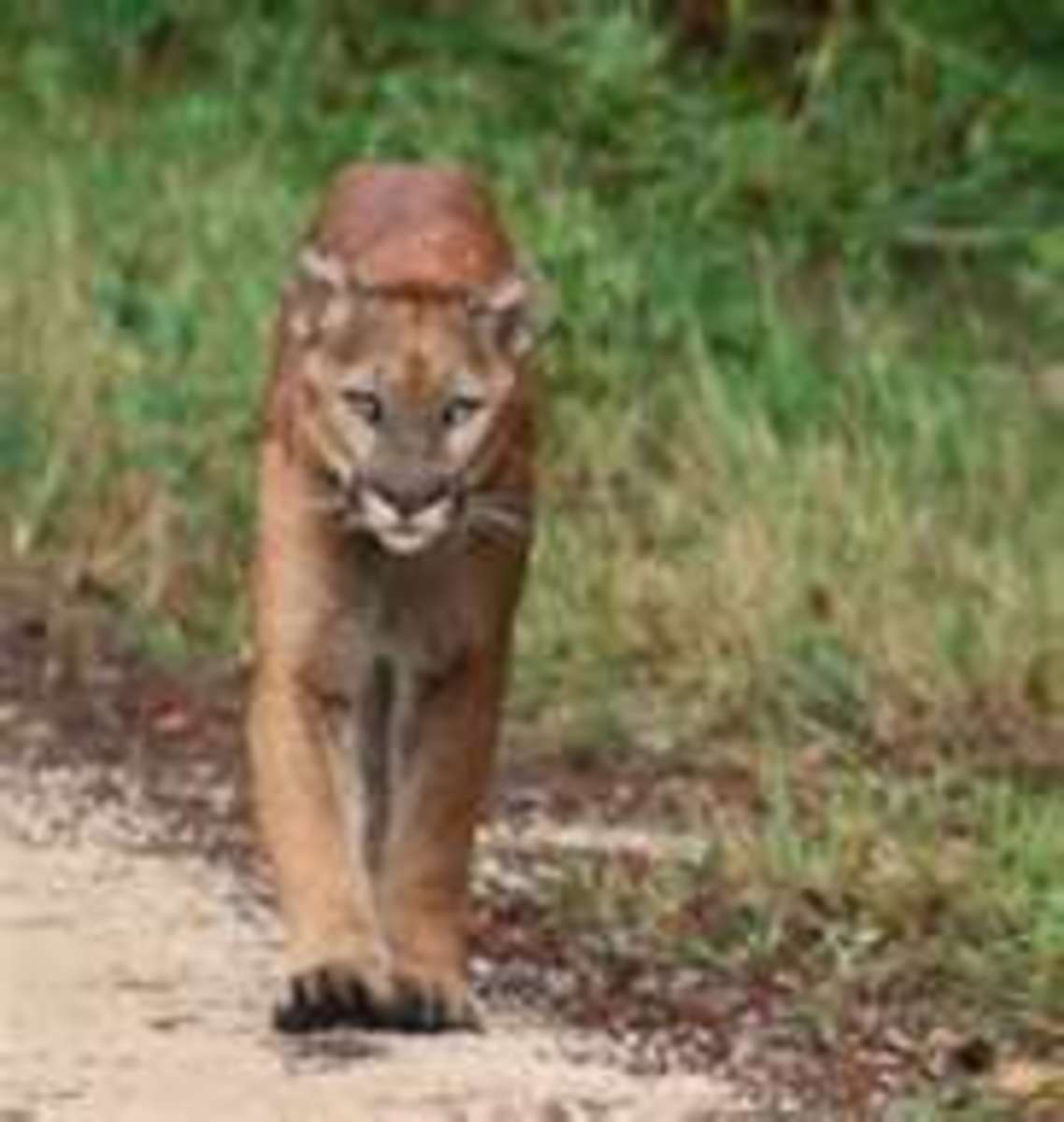Hummingbird Hill Backyard Habitat in Pictures
Hummingbird Slurping Bugs
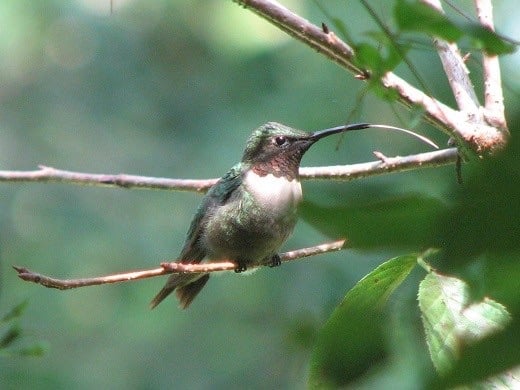
A National Wildlife Federation Backyard Wildlife Habitat
Our place called Hummingbird Hill is on the Little Tchefuncte River in Southeastern Louisiana. Everything we do here is because of our love of nature, animals, plants and the great outdoors. We enjoy Louisiana's scenic rivers and the abundant native plants and wildlife so we want to share them with the world. Most of the photographs featured here were taken both before and after Hurricane Katrina. The dog and cat subjects in our photos and art work are our very own, beloved rescued pets.
Our property is a registered National Wildlife Backyard Habitat and provides food, shelter/cover, nesting sites and water for the wildlife there. We are are currently replanting native trees and shrubs to replace the hundreds that were lost as a result of Hurricane Katrina, Hurricane Gustav and other catastrophes. Each day brings another small miracle to enjoy and to photograph.
All photographs are the property of Al and Y.L. Bordelon. All Rights Reserved.
Come in and See What's Here
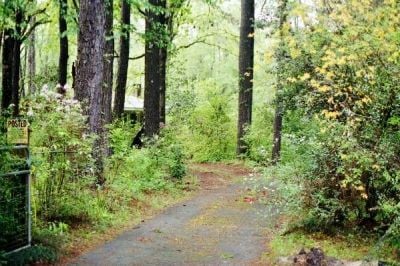
Welcome Wildlife into Your Backyard
Provide Food, Shelter, Nesting Sites and Water
For over 30 years we have maintained a National Wildlife Backyard Habitat. Our first one was in our 1/2 acre suburban lot in Baton Rouge and our current one occupies 9 acres along the Tchefuncte River in St. Tammany Parish. Through the years we have had many delightful encounters with different species of wildlife, everything from tiny native Bees and hummingbirds to White-tailed Deer plus many other creatures in between. Our habitat provides food for humans and animals alike. By using many multi-purpose native and naturalized plants, our gardens are sustainable and ecologically healthy.
Red-Shouldered Hawk
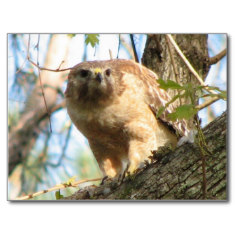
Prothonotary Warbler
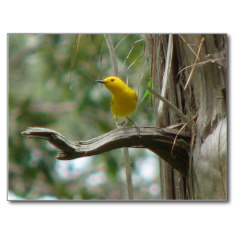
Biodiversity in plant and animal life is the key to a healthy habitat and a healthy environment. We have replaced the mono-culture of exotic lawn grass with low maintenance native and food producing plants. We still have some areas with St. Augustine and Carpet grass that we use as walkways and roads through the property, but have placed them so that they are easy to mow with the riding lawnmower. These areas are getting smaller everyday as the mulch and leaves cover the edges. The result has been the revitalization of native pollinators and the European honeybee as well as other beneficial insects. The cycle of life (producer, prey, predator) remains intact to perform as nature intended.
Red-shouldered hawks, a predator of the forest, are permanent residents here. The one shown here was photographed right after it captured a mourning dove. The uncommon, lemon yellow Prothonotary warblers return to breed in the wetland sections each year. They often use the houses that were built for the eastern bluebirds so populations are increasing.
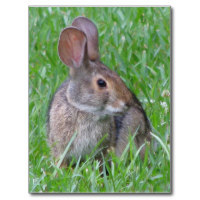
Habitats should maintain a balance of nature. The never ending cycle of producer, predator and prey keeps this balance. In our habitat, all native species: insect, arachnids, reptiles, amphibians, birds and mammals are allowed to live as they would in the wild. By providing wild areas for the animals we are able to keep the "management" of our habitat to a minimum and have been rewarded with a variety of beautiful and colorful creatures.
Cottontail rabbits abound in the field and the woodlands. We keep them from munching our garden plants by using solar ultrasonic motion sensor animal repellers. The red shouldered and red tailed hawks also keep numbers down.
Bringing Nature Home
Bringing Nature Home is a must read for anyone who is concerned about the quality of living on our planet. It discusses the importance of insects and native plants in the grand scheme of things. We can all help by planting more natives and cutting down on the use of pesticides and herbicides.
Scarlet Sage and Native Bee
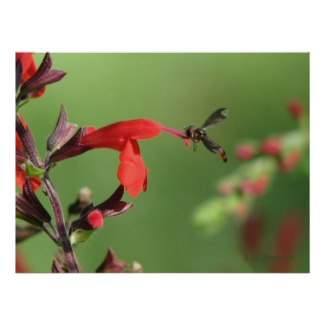
Spider on Sunflower
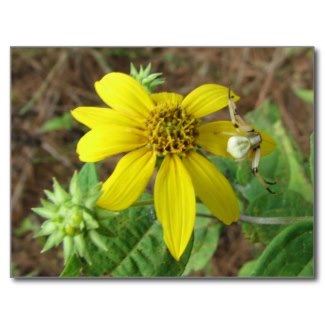
Throughout the garden we use organic and sustainable methods. Small predators such as golden orb and crab spiders act as a free pest control squad which patrols along with other hungry little creatures such as green anoles and toads to gobble up insect pests.
Native bees, butterflies and moths filled in when the European honeybee numbers declined. Here in South Louisiana, honeybees are back and the native pollinators are still going strong.
Habitat Poll
Do you use sustainable landscaping in your yard?
Cypress Vine and Ruby Throat Hummingbird
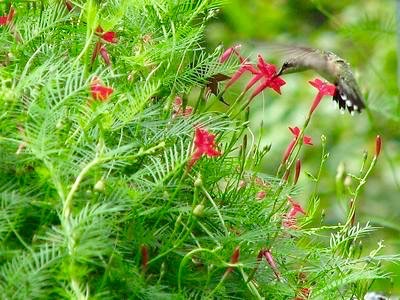
Male Cardinal Eating Sunflower Seeds
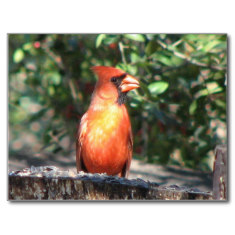
Requirements for Good Habitats
To attract and sustain wildlife in your garden or yard the 3 major requirements for the survival of any creature must be provided:
Food - in the form of plants (nectar, berry, and nut producing) and/or feeders.
Red-Bellied Woodpeckers' Nest Cavity
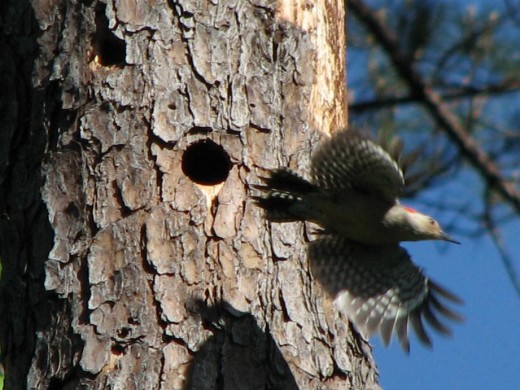
Eastern Bluebirds in Spring
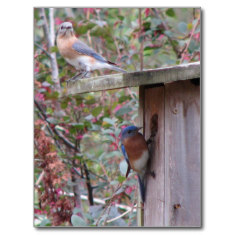
Shelter/ Cover/ Nesting Sites - Evergreens are especially important for wintering Hummingbirds and natives are preferred nesting sites. Nest boxes can also be a pleasing addition to the garden or dead trees and limbs can be left standing for woodpeckers, bluebirds, wood ducks and other cavity nesters. Many birds such as cardinals and towhees nest in thickets and shrubs.
There is nothing in which the birds differ more from man than the way in which they can build and yet leave a landscape as it was before.
— Robert Lynd, The Blue Lion and Other EssaysMost of the photos shown on this page are available as print-on-demand items from my Naturegirl7 Naturally Native Zazzle Shop.
Prothonotary Warbler Bath
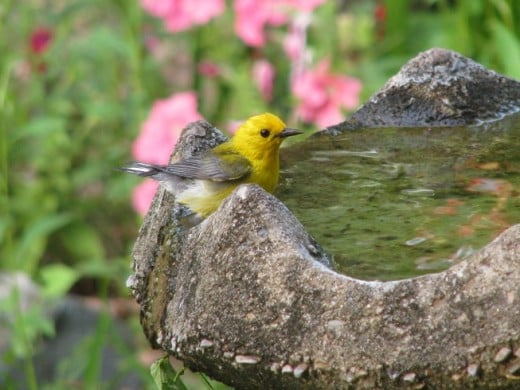
Water...
...from a large pond to a birdbath, but dripping or moving water is most appealing.
Solar Fountain for Bird Bath

Water is the most important element for survival of any species, whether it be plant or animal. Bird baths, ponds and water gardens come in all shapes and sizes and will attract all kinds of beneficial creatures to your habitat. Soon you'll find tadpoles and dragonfly larvae swimming around, that when mature, will devour many mosquitoes and other harmful insects. It is best to have circulation to keep the water fresh and if you have a pond, small fish will keep the mosquito larvae population down. We are on a well and use an old mister tube which now slowly drips so the water is always fresh and the moisture loving plants around it are always moist. If your water use is restricted and you don't want to use electricity, then there are many solar powered circulating pumps and some have batteries that store the energy for nighttime use.
Birds and other animals will flock to a water source (especially on hot days and during periods of drought). We've been able to photograph a variety of different birds enjoying a cool dip or a drink from our bird bath.
Blue Jay Bathing
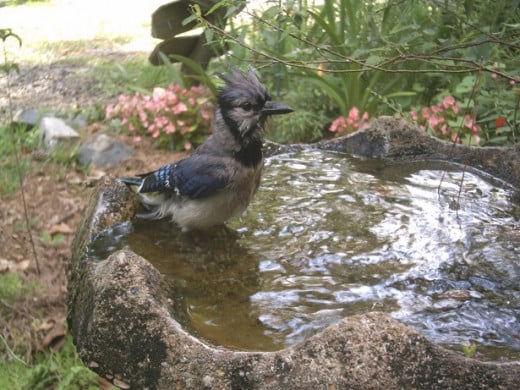
When one tugs at a single thing in nature, he finds it attached to the rest of the world.
— John Muir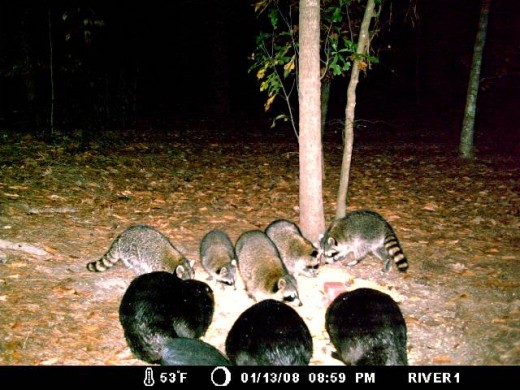
A Day on Hummingbird Hill
A typical day begins with the feeding of the birds and animals. Sunflower seeds and cracked corn are distributed among a dozen different feeding stations near the house and the suet feeders are also filled. We use black oil sunflower and safflower seed. Most birds eat the safflower readily, but the squirrels and raccoons don't seem to care for them so we save seed and money in the long run.
Our 15+ hummingbird feeders are also checked and observed. In the peak season during fall we fill the feeders every other day with a solution of 3 parts water and 1 part sugar.
A walk to the river with the dogs is next on the agenda, where a dozen more feeding stations are checked and filled and the wildlife camera memory card is changed. Scroll down to see photos of how the animals handled the big May 3, 2008 flood on the Tchefuncte River.
You may also enjoy visiting Creatures of the Night to learn more about the nocturnal animals that live in and around the river.
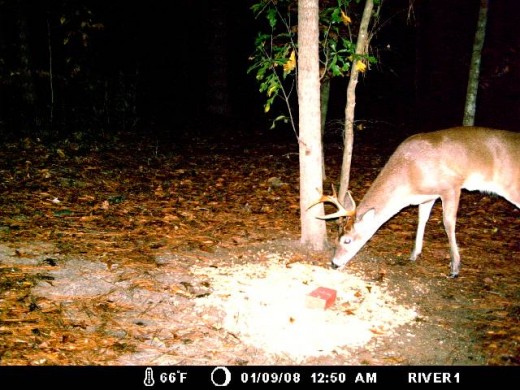
In addition to our regular activities, a typical Post-Katrina day may include cutting up and moving some of the 100 mature pine, black cherry, oak and hickory trees that were downed by the hurricane force winds and tornadoes. We chose to clear by hand instead of with a bulldozer so that as much of the existing under story trees and plants would remain intact. Most of the trails, feeding stations and nest boxes have been repaired or replaced, but limbs and dead trees are constantly falling, so we are still having to do some repairs.
For the last few years, we have been planting useful trees, shrubs and perennials throughout the cultivated area and in the forest. Some of the wild plums, mayhaws, blueberries and passionflower have borne fruit. Other fruiting plants include red mulberry, pears, kumquats and loquats.
I would feel more optimistic about a bright future for man if he spent less time proving that he can outwit Nature and more time tasting her sweetness and respecting her seniority.
— Elwyn Brooks White, Essays of E.B. White, 1977Tchefuncte River Flood - Photo Journal
Pictures from the Moultrie Wildlife Camera
The Tchefuncte River is ever changing. On May 3, 2008, the water began to rise on our sleepy little river. We knew that there had been torrential rainfall north of us, so we were expecting the water to rise a little. But, we didn't expect it to rise to 25.25 feet (flood stage is 20 feet). Here's the story as taken by the Moultrie Game Camera as the water began to rise during the night. The camera remained high and dry, about 2 feet above the water when the Tchefuncte crested. Notice the date, time, temperature and moon phase on each photo.
The Beavers and Raccoons are eating peacefully together, unaware that the water is steadily rising in the nearby Tchefuncte River.
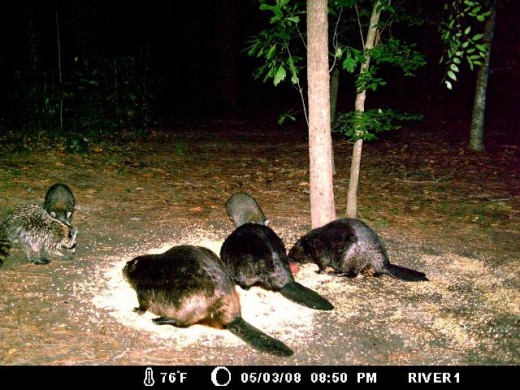
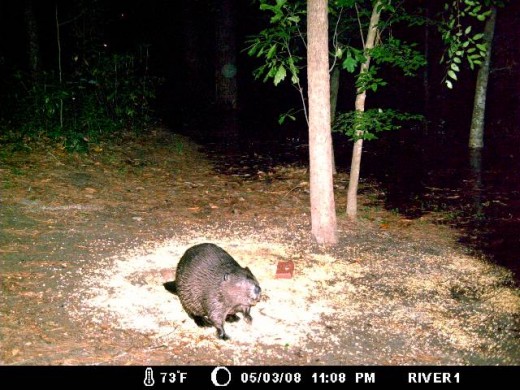
One lone beaver eats as the water inches nearer.
The river has left its banks and is beginning to surround the feeding area as the Raccoons and Beavers try to eat as much as they can.
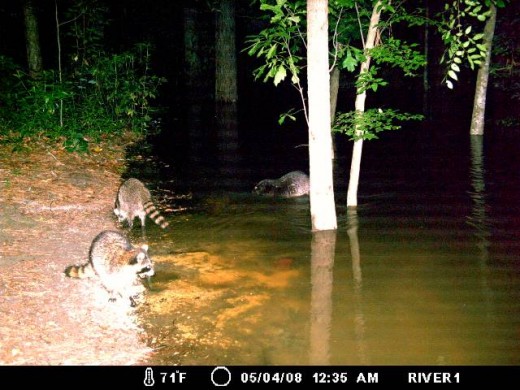
Since Raccoons will gather food from the water and often appear to "wash" their food, they are not bothered by the shallow water.
However as the water deepens, they give up and head for the safety of the trees.
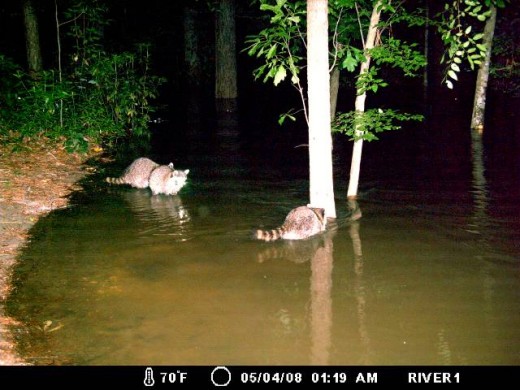
The water crested at around 11:30 on May 4th and Wood Ducks swim where the feeding spot once was.
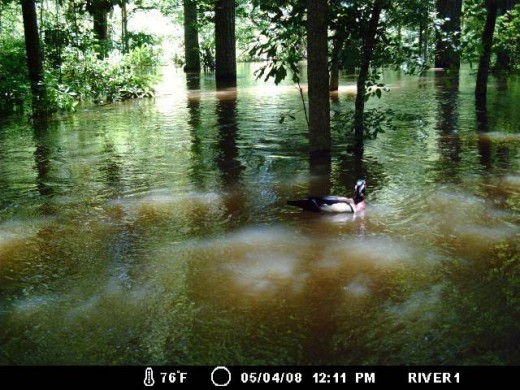
The next day, the water recedes and Rio and 2nd Chance investigate the new smells.
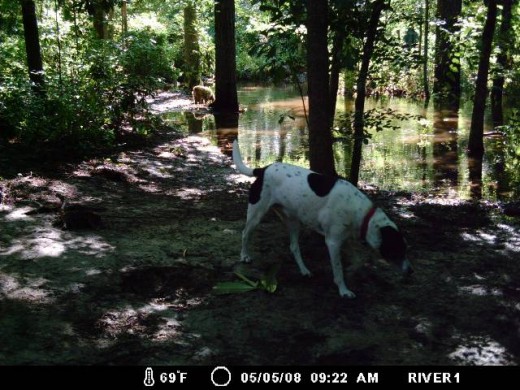
Wildlife Cameras Like Ours
We have a Moultrie M40 camera that automatically takes photographs day and night. It will also take video clips. We prefer the cameras that take color photos both day and night. The infrared types take black and white pictures and video at night.
We abuse land because we regard it as a commodity belonging to us. When we see land as a community to which we belong, we may begin to use it with love and respect.
— Aldo Leopold, Sand County AlmanacRed-bellied in Winter
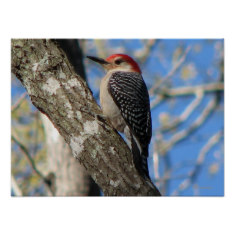
Photographs and Art from Nature - About Our Work and Interests
We have been drawing, painting and/or photographing the natural world for most of our lives. Our products on Zazzle and Cafepress reflect our connection with the outdoors. Our property provides a haven for the wild creatures that live in and around the Tchefuncte River. This is especially important in this post-Katrina world as we watch acres of native habitat being bulldozed each day to make way for development while hundreds of brand new houses sit empty.
Attracting Birds to Southern Gardens

Robin Redbreast
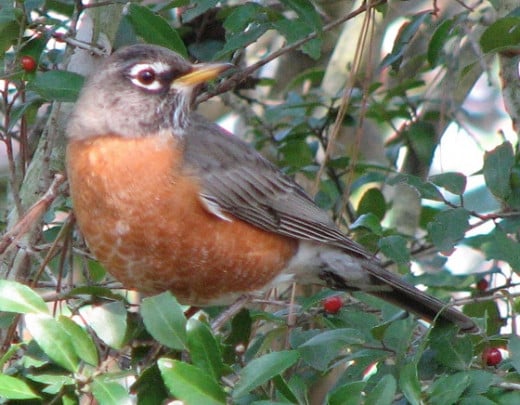
Magnolia
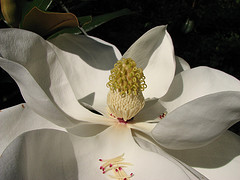
If you are interested in the native plants of Louisiana, you will enjoy our Folsom Native Plant Society website, where you will find galleries of photographs of our beautiful native plants, newsletters filled with useful information and pages about gardening with and propagating native plants. Folsom Native Plant Society is also on Facebook.
Forest Plants of the Southeast
Attracting Wildlife
Some wildlife can actually help the garden by acting as pest controllers and pollinators. By using native plants and others that provide food for humans and animals, you are one step closer to sustainability. There are many books which will aid you in creating a sustainable landscape and a habitat that will be a joy to you and to the wonderful wildlife.
You must teach your children that the ground beneath their feet is the ashes of your grandfathers. So that they will respect the land, tell your children that the earth is rich with the lives of our kin. Teach your children what we have taught our children, that the earth is our mother. Whatever befalls the earth befalls the sons of the earth. If men spit upon the ground, they spit upon themselves.
— Native American WisdomRed Spotted Purple Butterfly
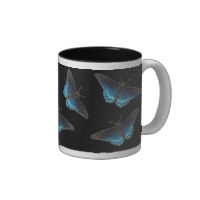
Naturally Native Gifts for the Nature Lover
The designs of the products that we offer on Zazzle were created from our original art work and photographs. We try to capture and convey the beauty and wonder of nature and the outdoors.
Mother Dove

Raccoon Pair
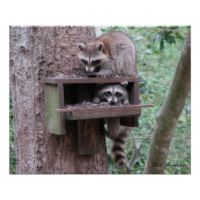
Suburban Wildlife
Doves will nest just about anywhere. Their nests are quite small and rather flimsy. This one was in a young pine tree in our yard in Baton Rouge.
Raccoons are common in the suburbs and the country. We have found that feeding safflower seed instead of sunflower will deter both squirrels and raccoons.
Habitat YouTube video Mister for Birds
Nature and Habitats Links
- Folsom Louisiana Native Plant Society
Photographs (4 Photo Galleries) and information about the native plants of Southeastern Louisiana and how to use them in landscaping. - Garden for Wildlife - National Wildlife Federation
Gardening for wildlife means you'll get to see beautiful butterflies and birds, as well as have a vibrant yard filled with native plants, so start your own wildlife habitat today with our help. - Backyard Nature with Jim Conrad
Backyard nature study
We have to shift our emphasis from economic efficiency and materialism towards a sustainable quality of life and to healing of our society, of our people and our ecological systems.
— Janet Holmes à Court© 2015 Yvonne L B
